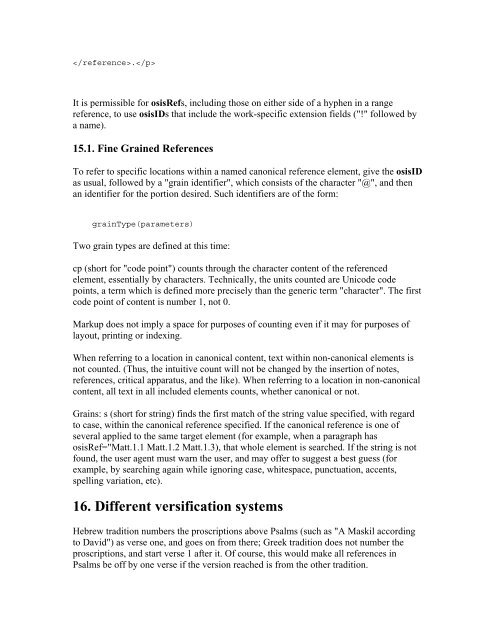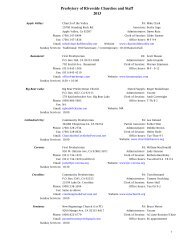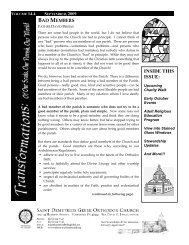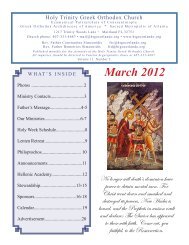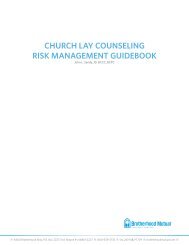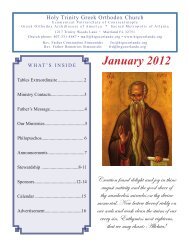OSIS? 2.0.1 User's Manual - Web services are running on AMBIB
OSIS? 2.0.1 User's Manual - Web services are running on AMBIB
OSIS? 2.0.1 User's Manual - Web services are running on AMBIB
Create successful ePaper yourself
Turn your PDF publications into a flip-book with our unique Google optimized e-Paper software.
.<br />
It is permissible for osisRefs, including those <strong>on</strong> either side of a hyphen in a range<br />
reference, to use osisIDs that include the work-specific extensi<strong>on</strong> fields ("!" followed by<br />
a name).<br />
15.1. Fine Grained References<br />
To refer to specific locati<strong>on</strong>s within a named can<strong>on</strong>ical reference element, give the osisID<br />
as usual, followed by a "grain identifier", which c<strong>on</strong>sists of the character "@", and then<br />
an identifier for the porti<strong>on</strong> desired. Such identifiers <str<strong>on</strong>g>are</str<strong>on</strong>g> of the form:<br />
grainType(parameters)<br />
Two grain types <str<strong>on</strong>g>are</str<strong>on</strong>g> defined at this time:<br />
cp (short for "code point") counts through the character c<strong>on</strong>tent of the referenced<br />
element, essentially by characters. Technically, the units counted <str<strong>on</strong>g>are</str<strong>on</strong>g> Unicode code<br />
points, a term which is defined more precisely than the generic term "character". The first<br />
code point of c<strong>on</strong>tent is number 1, not 0.<br />
Markup does not imply a space for purposes of counting even if it may for purposes of<br />
layout, printing or indexing.<br />
When referring to a locati<strong>on</strong> in can<strong>on</strong>ical c<strong>on</strong>tent, text within n<strong>on</strong>-can<strong>on</strong>ical elements is<br />
not counted. (Thus, the intuitive count will not be changed by the inserti<strong>on</strong> of notes,<br />
references, critical apparatus, and the like). When referring to a locati<strong>on</strong> in n<strong>on</strong>-can<strong>on</strong>ical<br />
c<strong>on</strong>tent, all text in all included elements counts, whether can<strong>on</strong>ical or not.<br />
Grains: s (short for string) finds the first match of the string value specified, with regard<br />
to case, within the can<strong>on</strong>ical reference specified. If the can<strong>on</strong>ical reference is <strong>on</strong>e of<br />
several applied to the same target element (for example, when a paragraph has<br />
osisRef="Matt.1.1 Matt.1.2 Matt.1.3), that whole element is searched. If the string is not<br />
found, the user agent must warn the user, and may offer to suggest a best guess (for<br />
example, by searching again while ignoring case, whitespace, punctuati<strong>on</strong>, accents,<br />
spelling variati<strong>on</strong>, etc).<br />
16. Different versificati<strong>on</strong> systems<br />
Hebrew traditi<strong>on</strong> numbers the proscripti<strong>on</strong>s above Psalms (such as "A Maskil according<br />
to David") as verse <strong>on</strong>e, and goes <strong>on</strong> from there; Greek traditi<strong>on</strong> does not number the<br />
proscripti<strong>on</strong>s, and start verse 1 after it. Of course, this would make all references in<br />
Psalms be off by <strong>on</strong>e verse if the versi<strong>on</strong> reached is from the other traditi<strong>on</strong>.


